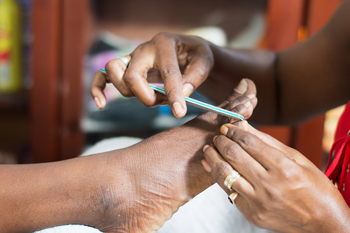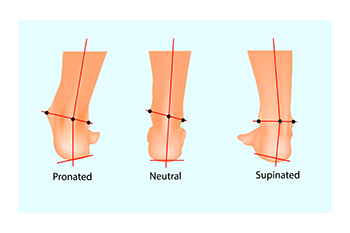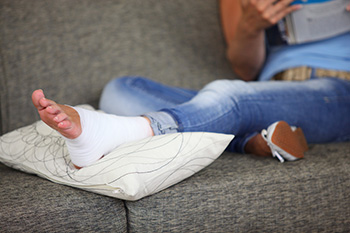Items filtered by date: October 2023
The Importance of Daily Foot Care

Our feet, often overlooked and underappreciated, are the unsung heroes that support your body every day. They endure a tremendous amount of stress and strain, yet it is common to neglect their care. Everyday foot care is not just a matter of comfort; it is a fundamental aspect of overall well-being. Neglecting foot health can lead to a host of problems, from painful calluses and ingrown toenails to more serious issues like fungal infections and chronic foot pain. Basic daily care involves washing and drying your feet, trimming toenails straight across, and wearing properly fitting shoes. Incorporating foot massages, stretches, and moisturizing into your routine can also enhance circulation and keep the skin supple. By taking a few minutes each day to care for your feet, you can maintain their health, prevent future problems, and ensure that they continue to support you in every step you take. There are a multitude of methods to maintain foot care. If you are interested in learning more about this, it is suggested that you visit a podiatrist who can guide you toward effective foot care techniques.
Everyday foot care is very important to prevent infection and other foot ailments. If you need your feet checked, contact Dr. Barbara Davis from Gilbert Podiatry. Our doctor can provide the care you need to keep you pain-free and on your feet.
Everyday Foot Care
Often, people take care of their bodies, face and hair more so than they do for their feet. But the feet are a very important aspect of our bodies, and one that we should pay more attention to. Without our feet, we would not be able to perform most daily tasks.
It is best to check your feet regularly to make sure there are no new bruises or cuts that you may not have noticed before. For dry feet, moisturizer can easily be a remedy and can be applied as often as necessary to the affected areas. Wearing shoes that fit well can also help you maintain good foot health, as well as making it easier to walk and do daily activities without the stress or pain of ill-fitting shoes, high heels, or even flip flops. Wearing clean socks with closed shoes is important to ensure that sweat and bacteria do not accumulate within the shoe. Clean socks help to prevent Athlete’s foot, fungi problems, bad odors, and can absorb sweat.
If you have any questions please feel free to contact our office located in Gilbert, PA . We offer the newest diagnostic and treatment technologies for all your foot and ankle needs.
Broken Foot Healing and Recovery

Managing a broken foot can be challenging, but understanding the healing process and recovery journey is important. Firstly, upon diagnosis, following a podiatrist's guidance regarding treatment is essential. Whether it is a cast, splint, or surgery, immobilizing the foot allows the bones to align and heal properly. Rest is paramount during the initial phase, in addition to minimizing weight-bearing and keeping the foot elevated to reduce swelling. As healing progresses, performing gentle exercises can help to regain strength, mobility, and flexibility. Recovery time varies depending on the severity of the break and individual healing capacity. On average, it can take several weeks to a few months to resume normal activities. Patience and adherence to medical advice is essential for a successful recovery, ensuring a strong foundation for a healthy foot. If you have broken your foot, it is strongly suggested that you seek the counsel of a podiatrist who can perform a proper diagnosis, and guide you toward the best treatment method for recovery.
A broken foot requires immediate medical attention and treatment. If you need your feet checked, contact Dr. Barbara Davis from Gilbert Podiatry. Our doctor can provide the care you need to keep you pain-free and on your feet.
Broken Foot Causes, Symptoms, and Treatment
A broken foot is caused by one of the bones in the foot typically breaking when bended, crushed, or stretched beyond its natural capabilities. Usually the location of the fracture indicates how the break occurred, whether it was through an object, fall, or any other type of injury.
Common Symptoms of Broken Feet:
- Bruising
- Pain
- Redness
- Swelling
- Blue in color
- Numbness
- Cold
- Misshapen
- Cuts
- Deformities
Those that suspect they have a broken foot shoot seek urgent medical attention where a medical professional could diagnose the severity.
Treatment for broken bones varies depending on the cause, severity and location. Some will require the use of splints, casts or crutches while others could even involve surgery to repair the broken bones. Personal care includes the use of ice and keeping the foot stabilized and elevated.
If you have any questions please feel free to contact our office located in Gilbert, PA . We offer the newest diagnostic and treatment technologies for all your foot and ankle needs.
Why Pronation of the Feet Matters

Understanding supination and pronation as they relate to the feet is essential for maintaining proper foot health. Supination refers to the positioning of your foot when your weight tends to be more on the outside during walking or running, essentially causing your foot to lean outward. Pronation means your weight tends to be more on the inside of your foot during these activities, causing your foot to lean inward. Ideally, during a proper stride, your foot should roll forward from heel to toe with neutral pronation, ensuring even weight distribution. Excessive supination places stress on the outer side of your foot and can lead to uneven wear on the outside of your shoe. It may result in various issues, including calluses, bunions, and pain in your heels and the balls of your feet. Excessive pronation involves your foot rolling toward the inside, leading to uneven wear on the inside of your shoe and potential pain in your arch, heel, and ankle. The causes of these pronation issues can be genetic, such as having a high arch or uneven leg lengths, or they can result from injuries, overuse, or walking on hard surfaces. Obesity or pregnancy may also increase overpronation. If you suspect issues with your foot mechanics, it is suggested that you make an appointment with a podiatrist for an exam and treatment plan options.
If you have any concerns about your feet, contact Dr. Barbara Davis from Gilbert Podiatry. Our doctor can provide the care you need to keep you pain-free and on your feet.
Biomechanics in Podiatry
Podiatric biomechanics is a particular sector of specialty podiatry with licensed practitioners who are trained to diagnose and treat conditions affecting the foot, ankle and lower leg. Biomechanics deals with the forces that act against the body, causing an interference with the biological structures. It focuses on the movement of the ankle, the foot and the forces that interact with them.
A History of Biomechanics
- Biomechanics dates back to the BC era in Egypt where evidence of professional foot care has been recorded.
- In 1974, biomechanics gained a higher profile from the studies of Merton Root, who claimed that by changing or controlling the forces between the ankle and the foot, corrections or conditions could be implemented to gain strength and coordination in the area.
Modern technological improvements are based on past theories and therapeutic processes that provide a better understanding of podiatric concepts for biomechanics. Computers can provide accurate information about the forces and patterns of the feet and lower legs.
Understanding biomechanics of the feet can help improve and eliminate pain, stopping further stress to the foot.
If you have any questions please feel free to contact our office located in Gilbert, PA . We offer the newest diagnostic and treatment technologies for all your foot and ankle needs.
Types and Severity of Ankle Sprains

Ankle sprains are a common injury that can happen to anyone, from athletes to those simply walking down the street. Understanding the different types and severity of ankle sprains is necessary for proper diagnosis and treatment. Mild ankle sprains typically involve stretching or slight tearing of the ligaments. These sprains are characterized by minimal pain and swelling and usually recover with rest, ice, compression, and elevation. Moderate ankle sprains, on the other hand, result in more extensive ligament damage, leading to more pain, swelling, and difficulty bearing weight or walking. Treatment often requires immobilization of the ankle joint with a brace or cast and can take several weeks to heal. Severe ankle sprains represent a complete tear of one or more ligaments, causing extreme pain, swelling, and instability. Bearing weight is impossible. In such cases, treatment may involve surgery and a months-long recovery period. Prompt evaluation and appropriate care for ankle sprains are essential to prevent chronic sprains. If you suspect an ankle sprain, it's suggested that you make an appointment with a podiatrist for a full exam and appropriate treatment based on the severity of your injury.
Although ankle sprains are common, they aren’t always minor injuries. If you need your ankle injury looked at, contact Dr. Barbara Davis from Gilbert Podiatry. Our doctor can provide the care you need to keep you pain-free and on your feet.
How Does an Ankle Sprain Occur?
Ankle sprains are the result of a tear in the ligaments within the ankle. These injuries may happen when you make a rapid shifting movement while your foot is planted. A less common way to sprain your ankle is when your ankle rolls inward while your foot turns outward.
What Are the Symptoms?
- Pain at the sight of the tear
- Bruising/Swelling
- Ankle area is tender to touch
- In severe cases, may hear/feel something tear
- Skin discoloration
Preventing a Sprain
- Wearing appropriate shoes for the occasion
- Stretching before exercises and sports
- Knowing your limits
Treatment of a Sprain
In many cases, the RICE method (Rest, Ice, Compression, and Elevate) is used to treat ankle sprains. However, you should see a podiatrist to see which treatment option would work best with your injury. In severe cases, surgery may be required.
It is important to ask your doctor about rehab options after you receive treatment for your injury. Stretching, strength training, and balance exercises may help the ankle heal while also preventing further injury.
If you have any questions, please feel free to contact our office located in Gilbert, PA . We offer the newest diagnostic and treatment technologies for all your foot care needs.
Insights Into Hammertoe Surgery

Hammertoe surgery is a procedure aimed at correcting a common and often painful foot condition known as hammertoe. This condition causes one or more toe joints to become permanently bent, resembling a hammer. If conservative treatments fail to provide relief, foot surgery may be recommended. Hammertoe surgery comes in different forms, including tendon transfers, joint resections, and fusion, tailored to the severity and type of deformity. It is typically performed as an outpatient procedure, allowing patients to return home on the same day. Recovery time can vary, and patients can expect swelling and discomfort for a few weeks, with full recovery taking several months. Hammertoe surgery boasts a high success rate in relieving pain and correcting toe deformities. However, understanding the facts about hammertoe surgery is the first step towards making an informed decision about your foot health. If you have a hammertoe, it is strongly suggested that you are under the care of a podiatrist who can determine if this type of foot surgery is correct for you.
Foot surgery is sometimes necessary to treat a foot ailment. To learn more, contact Dr. Barbara Davis of Gilbert Podiatry. Our doctor will assist you with all of your foot and ankle needs.
When Is Surgery Necessary?
Foot and ankle surgery is generally reserved for cases in which less invasive, conservative procedures have failed to alleviate the problem. Some of the cases in which surgery may be necessary include:
- Removing foot deformities like bunions and bone spurs
- Severe arthritis that has caused bone issues
- Cosmetic reconstruction
What Types of Surgery Are There?
The type of surgery you receive will depend on the nature of the problem you have. Some of the possible surgeries include:
- Bunionectomy for painful bunions
- Surgical fusion for realignment of bones
- Neuropathy decompression surgery to treat nerve damage
Benefits of Surgery
Although surgery is usually a last resort, it can provide more complete pain relief compared to non-surgical methods and may allow you to finally resume full activity.
Surgical techniques have also become increasingly sophisticated. Techniques like endoscopic surgery allow for smaller incisions and faster recovery times.
If you have any questions please feel free to contact our office located in Gilbert, PA . We offer the newest diagnostic and treatment technologies for all your foot and ankle needs.

